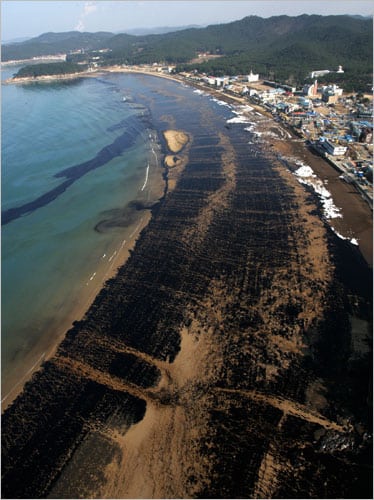President Obama said Tuesday that he has directed federal authorities to triple manpower in the Gulf of Mexico in places where oil from a ruptured underwater pipe has hit shore or is close to impact.
He added that a new presidential commission headed by former Florida Sen. Bob Graham and former Environmental Protection Agency Administrator William Reilly will “thoroughly examine the [BP oil] spill and its causes so we never face such a catastrophe again.”
Obama said he expects the commission to “follow the facts wherever they may lead” and report back to him in six months.
His administration “will bring those responsible to justice,” he said, insisting that BP will continue to be held accountable for the spill.
In an effort to control the message and release what it says is accurate information about the Gulf Coast oil spill, the Obama administration will no longer do joint briefings with BP, senior administration officials said Monday. Instead, all briefings will come from the administration’s point man on the disaster, Adm. Thad Allen.
The move comes amid growing concerns from the White House that BP is delivering inaccurate information and not being transparent, the officials said.
According to one official, the last straw was Saturday, when they say BP officials downplayed the possibility that the amount of oil flowing could actually increase from BP’s latest strategy to cut the pipe and cap the leak. Carol Browner, Obama’s assistant on energy and climate change, has said the flow of oil could increase by as much as 20 percent when the riser is cut.
The move also comes as the White House has been using progressively tougher language against BP after coming under fire for appearing to be the company’s “partner” in fighting the oil spill.
In the Gulf, an operation aimed at lessening the amount of oil gushing from the underwater well was under way Tuesday, weeks after a similar effort was abandoned, a BP official said.
“We want to minimize the flow of oil into the Gulf of Mexico, and we’re well into an operation to do that,” BP Managing Director Bob Dudley said.
Within hours, he said, robots will begin making a series of cuts to the “lower marine riser package” on the well. After that, a diamond-cut saw will be used to make a “clean cut,” preparing the way for a custom-made cap to be fitted over the package.
Dudley said the company is implementing new techniques in its ongoing effort to plug the leak.
Asked about his level of confidence in the capping procedure, given the fact that other operations aimed at stopping the spill have failed over the past 43 days, Dudley said the company has learned a lot from previous attempts.
An effort to cap the leak by lowering a containment dome on top of it in early May was foiled when ice-like hydrate crystals formed inside the vessel. This time, warm water will be pumped down in an effort to combat the formation of hydrates.
Although the engineering has never been attempted at a depth of 5,000 feet, Dudley said, it is “more straightforward” than that used in previous operations.
Oil has been gushing from the undersea well since April 20, when the Deepwater Horizon oil rig exploded and sank. Government estimates are that up to 19,000 barrels (798,000 gallons) of oil a day are flowing into the Gulf.
Oil has affected 24 miles of Louisiana coastline, Plaquemines Parish President Billy Nungesser said Tuesday.
The latest operation represents the first of three containment steps BP plans to take, he said. After the cap is on, a second operation will create a second flow path through the blowout preventers, meaning there will be two flow paths to the surface.
“By the end of the month, we are engineering a completely separate system that will make it more storm-proof, with a free-standing riser that would allow for quick disconnects if needed,” he said. “This engineering is different than the ‘top kill’ engineering.”
- Aziel Jackson – In His Own Words: Making His “FIRST MOVE” in Fashion - Thursday, March 14, 2024
- Miami Dolphins’ Stand-Out Terron Armstead Continues To Win In The Art of Giving-Back - Monday, June 5, 2023
- Delux Feature: Celebrity Barber and Fitness Trainer, Lawrence Roebuck, Shares His Tips for a Healthier Lifestyle During Stress Awareness Month - Monday, May 8, 2023







